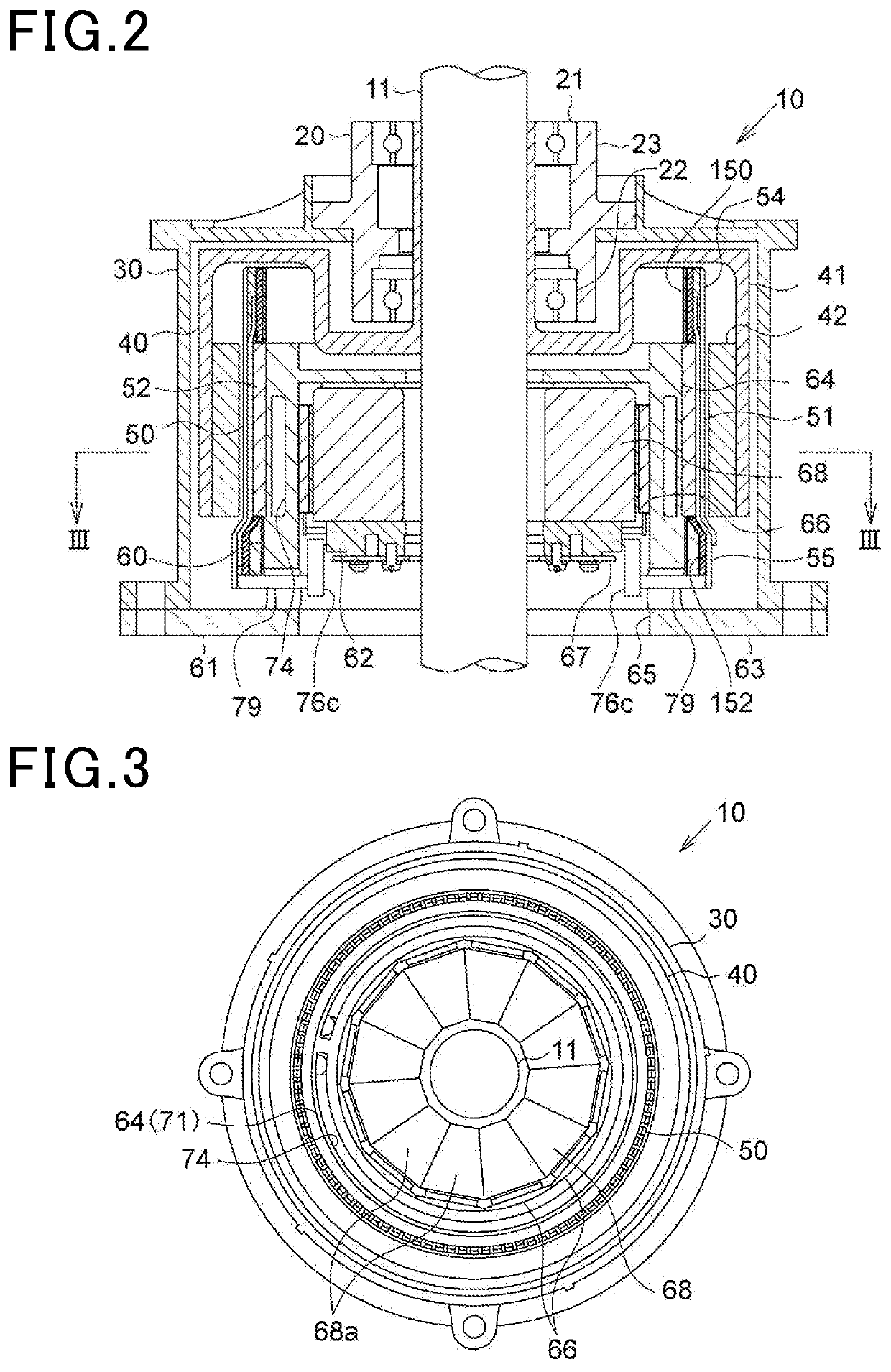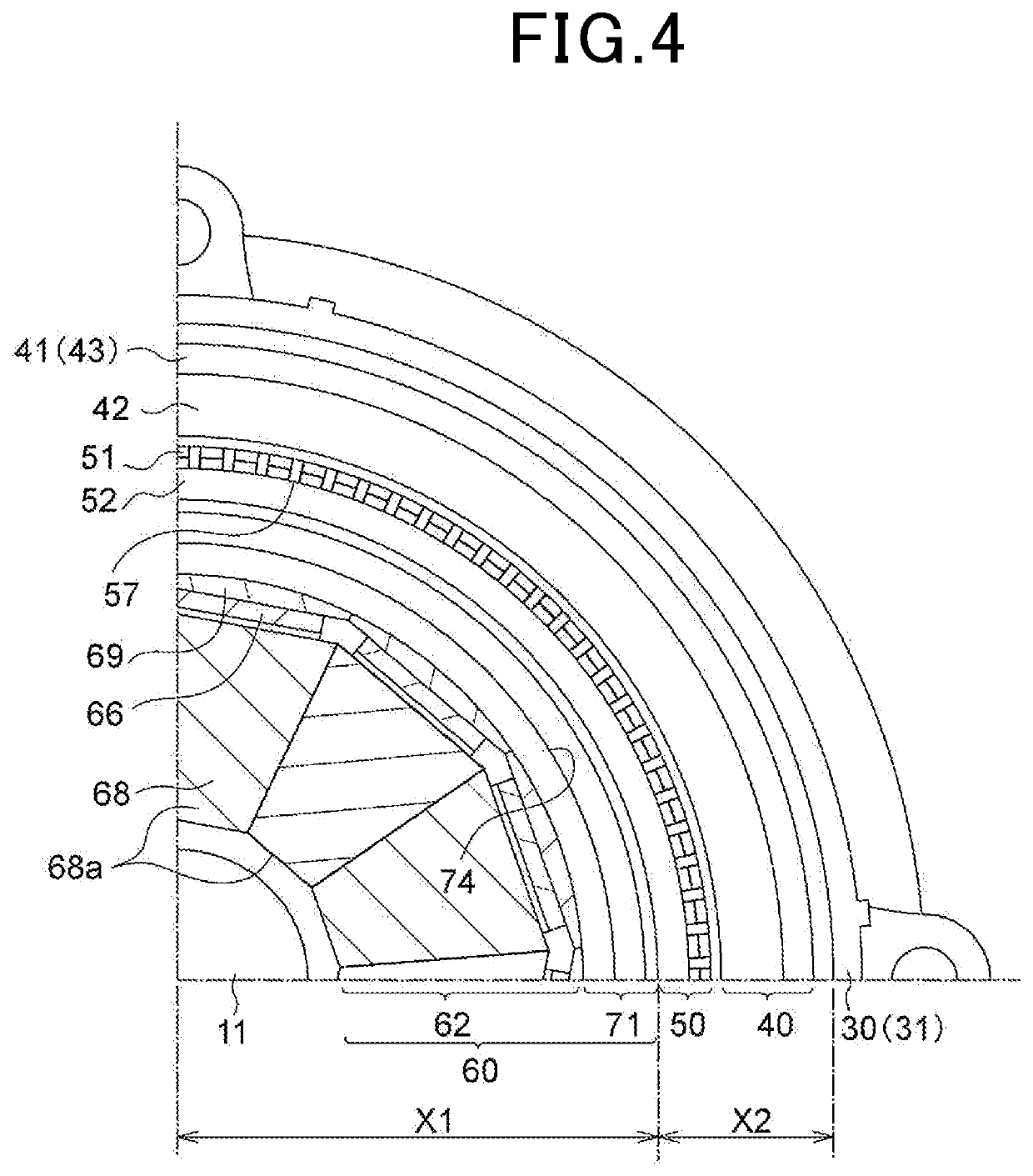Rotating electric machine
a technology of rotating electric machines and rotating parts, which is applied in the direction of rotating parts of magnetic circuits, magnetic circuits characterised by magnetic materials, and magnetic circuits. it can solve the problems of limited use practicability of coreless or toothless stators
- Summary
- Abstract
- Description
- Claims
- Application Information
AI Technical Summary
Benefits of technology
Problems solved by technology
Method used
Image
Examples
first embodiment
[0045]The rotating electric machine 10 according to the present embodiment is a synchronous multi-phase AC motor with an outer rotor structure (i.e., an outer rotating structure). The outline of the rotating electric machine 10 is illustrated in FIGS. 1 to 5.
[0046]FIG. 1 is a perspective longitudinal cross-sectional view of the rotating electric machine 10. FIG. 2 is a longitudinal cross-sectional view along a rotating shaft 11 of the rotating electric machine 10. FIG. 3 is a transverse cross-sectional view (i.e., cross-sectional view taken along the line III-III in FIG. 2) of the rotating electric machine 10 perpendicular to the rotating shaft 11. FIG. 4 is an enlarged cross-sectional view of part of FIG. 3. FIG. 5 is an exploded view of the rotating electric machine 10. In addition, it should be noted that in FIG. 3, for the sake of simplicity, hatching lines designating cross sections of components of the rotating electric machine 10 except for the rotating shaft 11 are omitted.
[...
second embodiment
[0167]In the present embodiment, the polar anisotropic structure of the magnet unit 42 of the rotor 40 is modified in comparison with that described in the first embodiment. The polar anisotropic structure according to the present embodiment will be described in detail hereinafter.
[0168]As shown in FIGS. 22 and 23, in the present embodiment, the magnet unit 42 is configured with a magnet array called a Halbach array. Specifically, the magnet unit 42 includes first magnets 131 each having its magnetization direction (or the orientation of the magnetic pole thereof) coincident with a radial direction and second magnets 132 each having its magnetization direction (or the orientation of the magnetic pole thereof) coincident with the circumferential direction. The first magnets 131 are arranged at predetermined intervals in the circumferential direction. Each of the second magnets 132 is arranged between one circumferentially-adjacent pair of the first magnets 131. In addition, the first...
first modification
[0218]FIG. 29 shows part of a soft-magnetic member 150 according to a first modification.
[0219]In this modification, the soft-magnetic member 150 is obtained by press-forming a long band-shaped sheet 153 into a hollow cylindrical shape; the sheet 153 is made of a soft-magnetic material (e.g., magnetic stainless steel). The soft-magnetic member 150 is mounted on the inner circumferential surface of the coil end part 54.
[0220]Moreover, on an outer circumferential surface of the soft-magnetic member 150, there are formed a plurality of protrusions 150A. The protrusions 150A extend along the turn portions 84 of the stator coil 51 obliquely with respect to the axial direction and are aligned with each other in the circumferential direction. The soft-magnetic member 150 is mounted on the inner circumferential surface of the coil end part 54 with the protrusions 150A fitted respectively into the gaps between the electrical conductors 82 in the coil end part 54. Consequently, the soft-magne...
PUM
 Login to View More
Login to View More Abstract
Description
Claims
Application Information
 Login to View More
Login to View More - R&D
- Intellectual Property
- Life Sciences
- Materials
- Tech Scout
- Unparalleled Data Quality
- Higher Quality Content
- 60% Fewer Hallucinations
Browse by: Latest US Patents, China's latest patents, Technical Efficacy Thesaurus, Application Domain, Technology Topic, Popular Technical Reports.
© 2025 PatSnap. All rights reserved.Legal|Privacy policy|Modern Slavery Act Transparency Statement|Sitemap|About US| Contact US: help@patsnap.com



